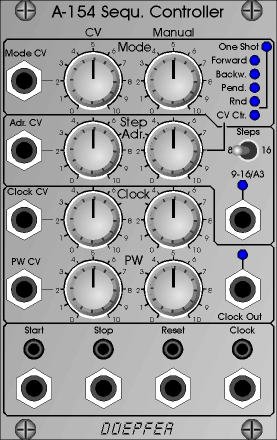A-154 Seq. Controller

Module A-154 is a supplement to the
A-155 Analog/Trigger Sequencer module.
It offers a lot of new features that are not available in the basic control
unit of the A-155. The A-154 is used to replace the control unit of
one or more A-155, i.e. the section marked "Control" with
Start / Stop / Step / Reset buttons and inputs in the upper left corner
of the A-155 front panel. If the A-154 is used to control the A-155 the
control section of the A-155 is put out of action.
The 10 pin ribbon cable, that was used to connect the A-155 control section
with the rest of the A-155 module has to be removed and plugged to the
new A-154 sequencer controller. Therefore the A-154 has to be assembled
next to the A-155 (right side). In case that more than one A-155 have
to be controlled longer ribbon cables between A-154 and the remote A-155
have to be used.
If two A-155 are used they can work in parallel (8 steps)
or serial (16 steps). The 8/16 steps switch determines
if the 8 step mode (one A-155 or two A-155 in parallel) or the
16 step mode (two A-155 serial) is chosen. Both modes work with
CV controlled step addressing too (see below). In 8 step mode only the
steps 1...8 are addressed, in 16 step mode the steps 1...16.
For serial operation an additional VC switch (A-150)
is required to switch between the CV/trigger/gates of the two A-155. In
this case the VC switch is controlled by the "9-16/A4" output
of the A-154.
The expected features of the A-154 will be:
- Several running modes: forward, backward,
pendulum, random, CV controlled step adressing. All
modes are available as loop or one-shot.
- LED display of the 5 different current
modes and one LED for loop/one-shot display.
- Manual and voltage controlled selection
(with attenuator) of the running mode. If no external control
voltage is applied one of the 10 modes (5 modes x 2 loop/one-shot) is
simply selected with a rotary knob. The CV input with attenuator is
used to modulate the running mode with an external control voltage (digital
high/low CV to switch between two modes or continuous analog CV to sweep
through different modes). With the combination of manual control and
CV with attenuator it is possible e.g. to use only two neighbouring
modes (e.g. forward/backward) or sweep through all possible running
modes.
- If the running mode "CV Controlled
Step Address" is selected the active sequencer step is determined
by the Step Address section. Manual and voltage controlled
selection (with attenuator) of the active step are possible:
the active step can be set by hand with the manual control and then
modulated by an external control voltage (e.g. LFO, Random, S&H,
Theremin, Light CV source, Joy Stick) with attenuator.
- An internal voltage controlled clock
generator with manual and CV control with attenuator is available.
The output of the clock generator is displayed with a LED and is used
as sequencer clock provided that no external clock signal is connected
to the Clock In socket (normalled socket). If the CV input of
the Clock section is connected to one of the analog outputs of the sequencer
the time for each step can be set separately. Even jumps (or skipping)
will be possible as we will introduce the feature that a very short
clock pulse will be generated if the control voltage exceeds a certain
value. For example the gate row of the A-155 can be used to obtain skipping
of steps: the gate output simply has to be conneted to the CV input
of the A-154 clock generator. If the corresponding switch of the A-155
is set correspondingly in the gate row the step will be skipped.
- Manual and voltage controlled (with attenuator) pulse width (PW) of the clock signal. This features can be used to obtain a different gate length for each step: one of the CV outputs of the A-155 has to be connected to the PW CV input of the A-154. With a PW control voltage coming from a LFO/random/S&H the gate length will change automatically.
- 8/16 step mode selected by a switch:
the "16 step" mode requires two A-155 and an VC switch A-150.
The A-150 is controlled by the "9...16/A4" output of the A-154
that tells the A-150 to select the CV/trigger/gates of the first A-155
(step 1...8) or second A-155 (step 9...16).
- The functions of the Start/Stop/Step/Reset
buttons and inputs are the same as for the "old" control unit
of the A-155:
- A high level at the Start input
or operating the Start button starts the sequence from the momentarily
addressed step
- A high level at the Stop input
or operating the Stop button stops the sequence (the last active
step remains addressed)
- A high level at the Reset input
or operating the Reset button resets the sequence to step 1.
The sequence remains at step 1 as long as the Reset input level is high
(function is activated by high level, not by low/high transition)
- A positive transition (low -> high) at the Step input or operating the Step button causes an advance to the next step. The step input is connected to the clock output of the internal clock generator provided that no plug is inserted to the step input socket